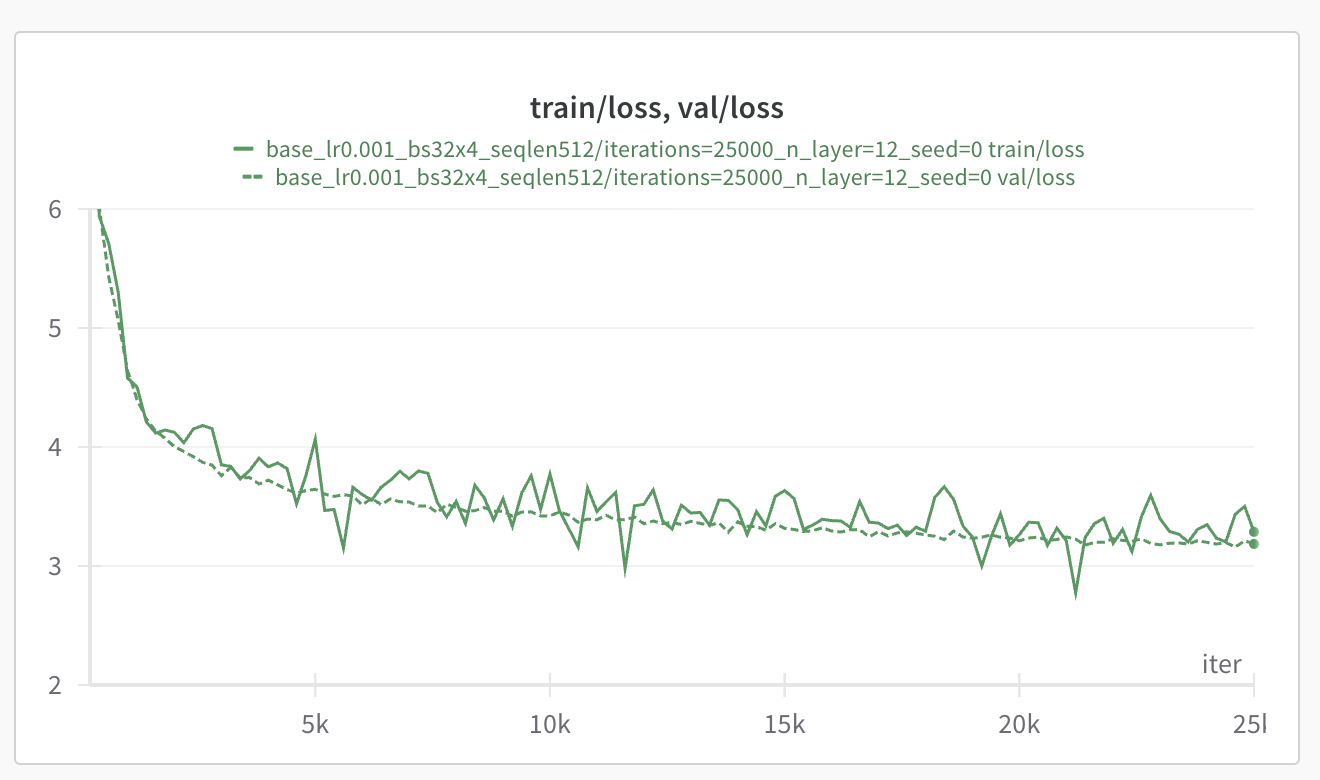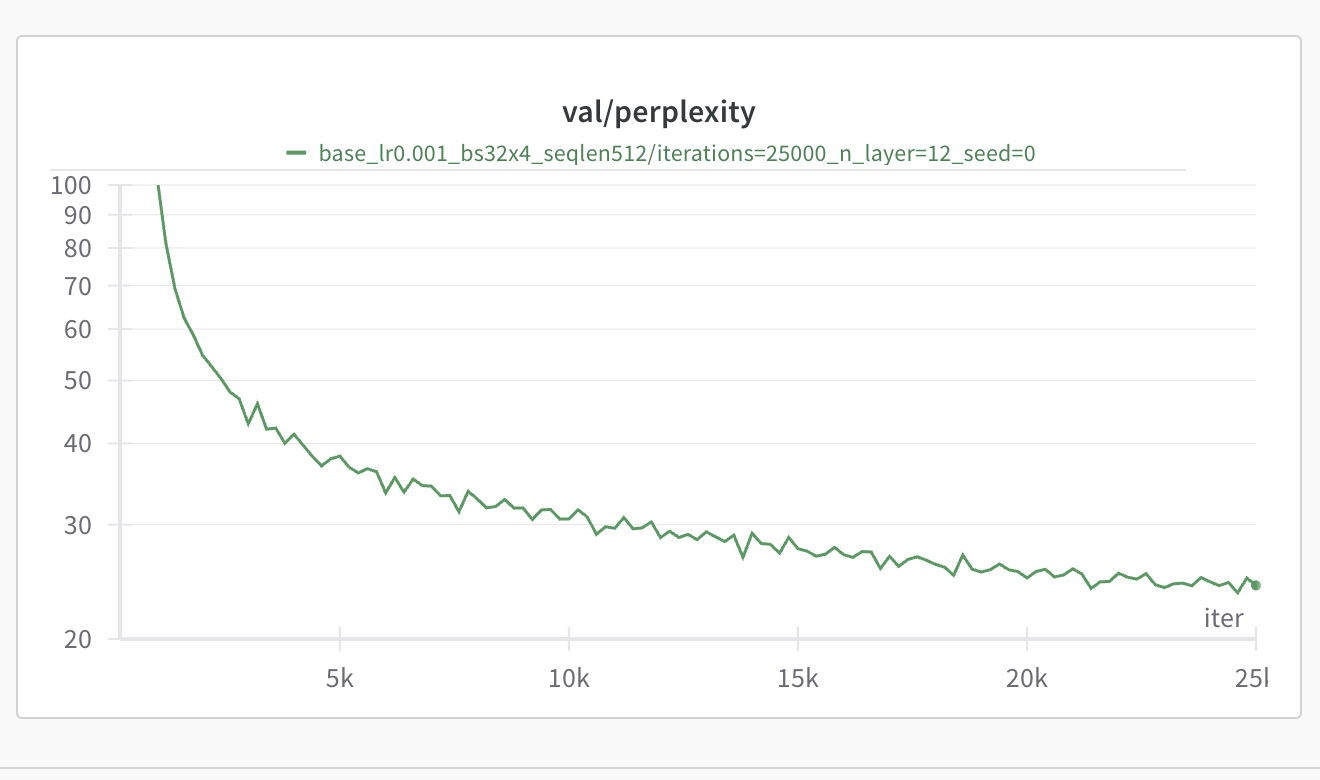A modular codebase to experiment with transformers, inspired by NanoGPT.
Install dependencies:
pip install -r requirements.txt
Run a simple training on the Slimpajama dataset (6B subset, 24GBs decompressed, takes a few minutes to download):
python ./src/main.py --config_format baseThe above command trains a 123.59M parameters model. It trains for 25k iterations with a batch size of 128=32x4 (4 gradient accumulation steps), using a cosine schedule with a maximum learning rate of 1e-3 that is reduced to 1e-4 at the end of training. The model is saved in the ./exps folder.
This training takes roughly ~3h on a single A100 (80GB) GPU. The plot of the training and validation loss should look roughly like this:
You can check out the wandb run for yourself here.
Here are the possible parameters you can use (copypasted from config/base.py):
# General training params
parser.add_argument('--batch_size', default=32, type=int)
parser.add_argument('--acc_steps', default=4, type=int)
parser.add_argument('--seed', default=0, type=int) # random seed for the parameters
parser.add_argument('--data_seed', default=1337, type=int) # random seed defining the data ordering
parser.add_argument('--device', default='cuda:0', type=str) # see below to run on multiple GPUs
parser.add_argument('--iterations', default=25000, type=int) # total number of training iterations
parser.add_argument('--lr', default=1e-3, type=float)
parser.add_argument('--warmup_percent', default=0.05, type=float) # the total number of warmup steps is iterations * warmup_percent
parser.add_argument('--weight_decay', default=0.1, type=float) # I recommend you keep this value, else instabilities might arise
parser.add_argument('--beta1', default=0.9, type=float) # adam parameter
parser.add_argument('--beta2', default=0.95, type=float) # adam parameter
parser.add_argument('--scheduler', default='cos', choices=['linear', 'cos', 'none'])
parser.add_argument('--opt', default='adamw', choices=['adamw', 'sgd'])
parser.add_argument('--eval_freq', default=200, type=int) # in iterations
parser.add_argument('--results_base_folder', default="./exps", type=str) # where the checkpoints will be saved
parser.add_argument('--grad_clip', default=0.0, type=float) # default value is 1.0 in NanoGPT
# Dataset params
parser.add_argument('--dataset', default='slimpajama', choices=['slimpajama', 'wikitext', "shakespeare-char", 'arxiv', "arxiv2000", "arxiv+wiki", 'openwebtext2'])
parser.add_argument('--vocab_size', default=50304, type=int)
parser.add_argument('--data_in_ram', action='store_true') # force the data to RAM, you most likely do not need this
# Model params
parser.add_argument('--model', default='base', choices=['base', 'llama2'])
parser.add_argument('--use_pretrained', default="none", type=str) # 'none', 'gpt-2' or a path to the pretraind model
parser.add_argument('--dropout', default=0.0, type=float) # keep to 0 unless in low data regime (e.g. wikitext)
parser.add_argument('--n_head', default=12, type=int)
parser.add_argument('--n_layer', default=12, type=int) # depth in (att + ff) blocks
parser.add_argument('--n_embd', default=768, type=int) # hidden size ...
parser.add_argument('--sequence_length', default=512, type=int)
parser.add_argument('--dtype', default=torch.bfloat16, type=torch.dtype)
parser.add_argument('--bias', default=False, type=bool)
parser.add_argument('--compile', action='store_true') # if true then model is compiled
parser.add_argument('--rmsnorm_eps', default=1e-5, type=float) # used by the llama model
parser.add_argument('--multiple_of', default=256, type=int) # used by the llama model make SwiGLU hidden layer size multiple of large power of 2
# logging params (WandB)
parser.add_argument('--wandb', action='store_true') # whether to use wandb or not
parser.add_argument('--wandb_project', default="my-project", type=str)
parser.add_argument('--wandb_run_prefix', default="none", type=str) # is added before the autogenerated experiment name
parser.add_argument('--eval_seq_prefix', default="Once upon a time", type=str) # prefix used to generate sequences
# Distributed args
parser.add_argument('--distributed_backend', default=None, type=str, required=False,
choices=distributed.registered_backends()) # distributed backend type (e.g. nccl)
parser.add_argument('--save_checkpoint_freq', default=None, type=int, required=False)You need to give your wandb authorize key in order to send the data to your wandb account. If you start jobs on a server without access to prompt, then you can set the WANDB_API_KEY variable within your script:
# this is a script that could be executed on a server
pip install -r requirements.txt # install req.
export WANDB_API_KEY="put your authorize key here, to find it: https://wandb.ai/authorize"
python ./src/main.py --config_format base --wandb --wandb_project "my awesome project" --n_layer 7 --model base --seed 123The structure of the project is the following:
src/
main.py # pick the right data, model, and training function
config/
__init__.py # contains CONFIG_FORMAT_TO_MODULE_MAP mapping the name given to the --config_format flag with a python conf file
base.py # config for the base model
data/
utils.py # contains the get_dataset function
wikitext.py # load/process wikitext
arxiv.py # load/process arxiv
shakespeare.py # load/process the Shakespeare dataset
slimpajama.py
...
models/
utils.py # contains the get_model function
base.py # contains the standard transformer base architecture
llama.py # llama architecture
optim/
utils.py # contains eval and get_batch functions
base.py # training function for the base and llama models
distributed/
# code to enable simple distributed trainingGiven the above structure, to add your own model, you can just fork the ./src/models/base.py file, do your modifications, then if necessary fork the ./src/optim/base.py in case you need some custom training loop or evaluation. You also need to fork the ./src/config/base.py file to add your own parameters, which imply adding your new config to the mapping CONFIG_FORMAT_TO_MODULE_MAP in ./src/config/__init__.py. To add a new dataset, create a new file in the data folder, check wikitext.py for the expected format.
Given a multi-GPU machine with e.g. 4 GPUs, one can distribute the training using data-parallelism:
torchrun --nproc_per_node=4 ./src/main.py --config_format base --distributed_backend nccl --dataset slimpajama --model baseWhen using multiple GPUs, the data will be distributed among the GPUs by dividing the number of accumulation steps by the number of nodes. For instance if we train with a batch size of 32 and 4 accumulation steps, then each GPU will process batches of 32 elements and do 1 accumulation steps. For this reason we require acc_steps to be a multiple of the number of GPUs.
If do not have access to a GPU or just want to try the code locally on your device, you can try the Shakespeare dataset with character-level tokens:
python ./src/main.py --n_layer=2 --n_head=4 --n_embd=128 --sequence_length=256 --dataset=shakespeare-char --device=cpu --vocab_size=96
